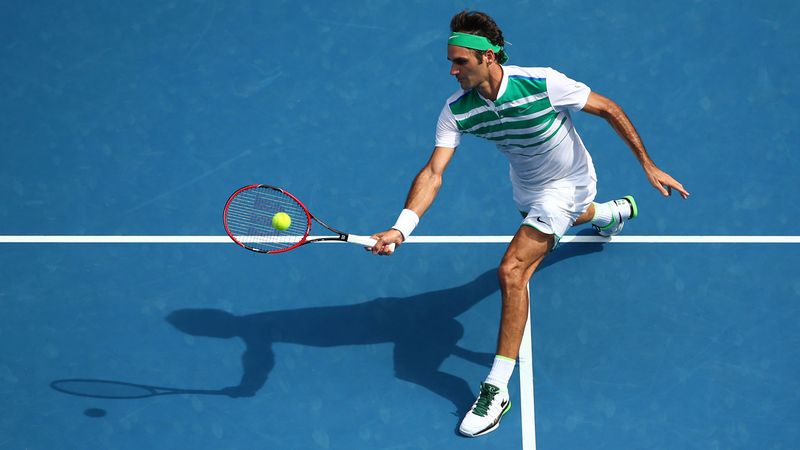THE JOURNAL

Mr Roger Federer during the Australian Open, 26 January 2016. Photograph by Quinn Rooney/Getty Images
Ahead of Wimbledon, we reveal four secrets to the tennis champion's success on the court, so you too can have a shot at winning a Grand Slam.
In his Wimbledon whites, Mr Roger Federer will hit a kaleidoscope of shots on Centre Court this summer. He will bring colour and creativity to the grass. There will be a temptation to believe his elegant tennis is played on instinct. On a whim.
But artistry alone, or a kind of free-form tennis, hasn’t brought the Swiss an unprecedented 17 Grand Slams titles, seven of which he won on the lawns of London. Perhaps more than anyone else in the sport, Mr Federer thinks about the strategies, patterns and psychologies of contending for the biggest prizes. By analysing his and others’ data for my new book Fedegraphica – and also through speaking to those close to Mr Federer, and to other players and coaches – I have learnt the secrets of the greatest tennis player in history.
Here’s an insight into Mr Federer’s winning moves – which could land him a record eighth title in men’s singles at this summer’s Wimbledon – arranged into four tips on how to play like him (well, almost).

Confuse Them With Your Serving Strategy
Mr Federer’s opponents are often unaware of how they are being manipulated – they are forever saying he doesn’t have any patterns on his serve. One of his ploys is to hit wide serves on the opening two points of a service game. Should Mr Federer take a 30-love lead, his opponent will be conditioned to believe that the Swiss will again serve wide, and so will lean that way. But it’s then that he’ll hit the ball down the “T”, and it's likely that the opponent will only have a meek response. While that sounds simple, the tennis champion has disguised that and other strategies by creating the perception of a mix by choosing “secondary” serves. At 40-love, he won't tend to hit one of his favourite serves, but will instead try something different, such as a body serve, or by going for more power on his delivery.

Stop And Go (But Not Very Far)
One way of appreciating Mr Federer's movement is to turn up the volume on your television to dangerously high levels and listen to the hush on his side of the net. He has, arguably, the quietest feet in tennis. The alternative is to look at the data illustrating how Mr Federer doesn't cover as much ground as his rivals, whether at Wimbledon or at the other Grand Slams, which is thanks to his attacking game and keeping the points short. On average, at last summer's Wimbledon he ran 10.13 metres per point, while Mr Novak Djokovic’s mean was 10.50 metres per point, with Mr Rafael Nadal averaging 10.52 metres and Mr Andy Murray 10.57 metres. Anyone wishing to follow Mr Federer’s example should work on their explosive power and ability to accelerate when they push off. His fitness trainer, Mr Pierre Paganini, notes that you rarely run that far in tennis, but you are instead “doing a lot of stop and go, stop and go”.

Dazzle Them With Your Backhand Spin
Mr Federer’s backhands fizz through the air like no others, spinning at up to 5,300 revolutions per minute; that's more spin than Mr Nadal’s shot, which has a maximum of 4,300 RPM, and also Mr Djokovic’s backhand (2,800 RPM) and Mr Murray’s (2,500 RPM). While the great majority of players have two hands on the racket when playing a backhand, Mr Federer has just the one. That earns him style points; it also enables to put more spin on the ball. Mr John McEnroe’s analysis is that Mr Federer’s heavily-spun, sliced backhands put great uncertainty in an opponent's mind. He’ll slow the point down with a sliced backhand, and then when he plays his next shot on that wing – probably a flat or topspin backhand, which will be travelling at much greater speed – it will have much more impact.

Don’t Fall For The Illusion Of The Open Court
Almost every tennis player is deceived by an apparently open court, and will prematurely go for a winning shot, not appreciating that their opponent will probably reach the ball with some ease. Mr Federer, though, likes to hit a forehand behind his adversary, who will then have to stop, change direction, and then reset his hands and feet. By playing two or three shots behind his opponent, Mr Federer will create a giant hole, and then the open court won't be an illusion for him.
Fedegraphica: A Graphic Biography Of The Genius Of Roger Federer (Aurum Press, £20) by Mr Mark Hodgkinson, is out now